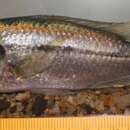Diagnostic Description
provided by Fishbase
Diagnosis: relatively robust, body depth 29.5-35.4% of standard length; mouth large, upper jaw (28.5-35.2% HL); lateral line system on head not notably enlarged; coloration dominated by a continuous mid-lateral band running from opercle to mid-level of caudal peduncle; microbranchiospines present on outer faces of second through fourth gill arches (Ref. 81260).Description: snout 30.5-40.0% HL; preorbital depth 18.5-24.0% HL; outer teeth in oral jaws with 2 unequal cusps or minor cusp reduced to a shoulder or absent; inner row teeth tricuspid at all sizes; lower pharyngeal jaw slightly longer than wide, teeth small and hooked; gill rakers small, conical; ; microbranchiospines present; lateral line system on head not enlarged or inflated (Ref. 81260).Coloration: base body coloration silvery grey with some brassy iridescence (Ref. 81260). Continuous, dark grey-black mid-lateral band present from opercle to mid-level of caudal peduncle (Ref. 52307, 81260). Often a dark spot at caudal base; dorsal, caudal and pectoral fins watery yellow, orange-yellow in mature males; pelvic and anal fins dusky grey; large "tilapia spot" present in soft dorsal fin of juveniles, this spot fades with age but a trace may be retained in adults (Ref. 81260).
Life Cycle
provided by Fishbase
Females are mouthbrooding.
Morphology
provided by Fishbase
Dorsal spines (total): 14 - 15; Dorsal soft rays (total): 10 - 12; Analspines: 3; Analsoft rays: 9 - 10
Biology
provided by Fishbase
Seems to prefer the more open regions of the lake; vagabonding, fast-swimming species; ovophilic, maternal mouthbrooder (Ref. 52307). Predatory; reported to kleptoparasitize the freshwater crab Potamon africanus (Ref. 81260). Prefers small fish, shrimp and insect larvae (Ref. 52307). Aquarium conditions: pH=9, H=25, 30°C water temperature, omnivore, egg layer, needs rocky cover and substratum, not easy to raise in tanks (Ref. 6398).
Importance
provided by Fishbase
fisheries: ; aquarium: commercial
Nsess: Brief Summary
provided by wikipedia EN
The nsess (Stomatepia mariae) is a species of cichlid endemic to Lake Barombi Mbo in western Cameroon. It can also be found in the aquarium trade. It is critically endangered because of pollution and sedimentation due to human activities. It is potentially also threatened by large emissions of carbon dioxide (CO2) from the lake's bottom (compare Lake Nyos), although studies indicate that Barombo Mbo lacks excess amounts of this gas.
The nsess can reach up to 12 centimetres (4.7 in) in standard length and is predatory; it sometimes steals prey from the freshwater crab Potamon africanus.
- license
- cc-by-sa-3.0
- copyright
- Wikipedia authors and editors

